Richard Wagner’s epic artistic extravaganza, Der Ring des Nibelungen, is a bucket list item for some and an obsession for others aching for immersion into its mix of myth and reality, while its intricacies of life and relationships at both a micro and macro level tick away. In four parts, there’s more than 15 hours of music drama to plunge into. After more than 40 years, it has returned to Theater Basel, in a city ranked as one of the largest cultural centres in relation to its size and population in Europe.
Those credentials were certainly evident in a visually and intellectually dense production by Artistic Director Benedikt von Peter, in yet another signature on a work that has continued to inspire creative expression since its premiere as a complete cycle at Wagner’s purpose-built Bayreuth Festspielhaus in 1876.
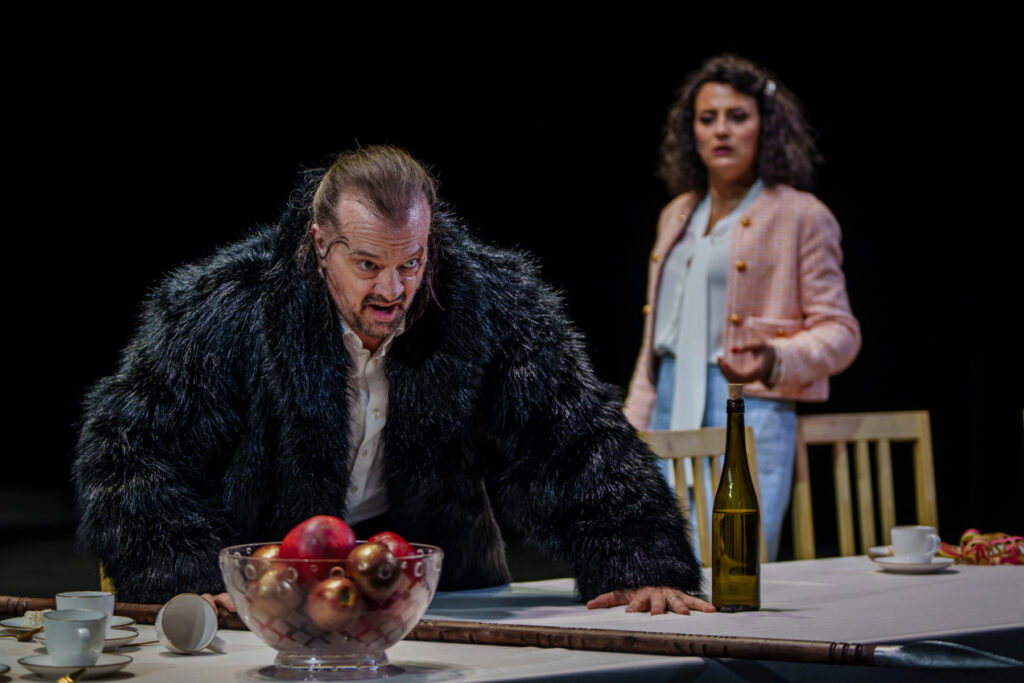
Assigning meaning to the Ring remains, as always, the mission of those who involve themselves with it — both artistic interpreters and the audience. Of his new production, von Peter says that it ‘examines the effects of Wotan’s patriarchal rule of power on subsequent generations’. It was Brünnhilde, Wotan’s Valkryie daughter, however, who was at the centre of this interpretation as she pondered on the forces and actions within her family. The dysfunctional nature of these familial relationships were glaring.
For that purpose, in what many would have thought of as sacrilegious, Brünnhilde was on stage from the start as an observer. A succession of voiceovers from her perspective throughout the cycle attempted to guide the audience. Yes, you learnt that Brünnhilde was psychologically tortured by her love and loyalty to a father who ruled with an iron fist and who eventually stumbled about in alcoholic unpredictability. But the voiceovers did little more than interrupt the flow of Wagner’s music-drama. None felt more intrusive than in Die Walküre when Brünnhilde appeared to Siegmund to tell him of his impending death as some of Wagner’s most radiant music followed.
English conductor Jonathan Nott did a remarkable job in accommodating these intrusions, presiding over the Basel Symphony Orchestra with utmost care in extracting the best from the depths of Wagner’s score. Great sensitivity and drama without resorting to pomposity were the hallmarks of Nott’s reading. Notably, unseen and positioned under the stage, the music filtered through from stage floor grills into the theatre with striking shape and clarity. Wagner would have delighted in its execution. The musical performance and its successful delivery brought a standing ovation when they took the stage at the cycle’s final curtain call.
When the curtain went up on Das Rheingold, Brünnhilde was there, trying to understand how things got to be the way they are. The child Siegfried was surprisingly there, too, as was a young Brünnhilde and what seemed the entire extended family. It was Siegfried’s 5th birthday and he got a little puppet theatre as a present from Wotan containing all the characters of the Ring. They were all so cute and some of their application and transformations made in progressing the story were both clever and impactful. But almost always, they also became confusing.
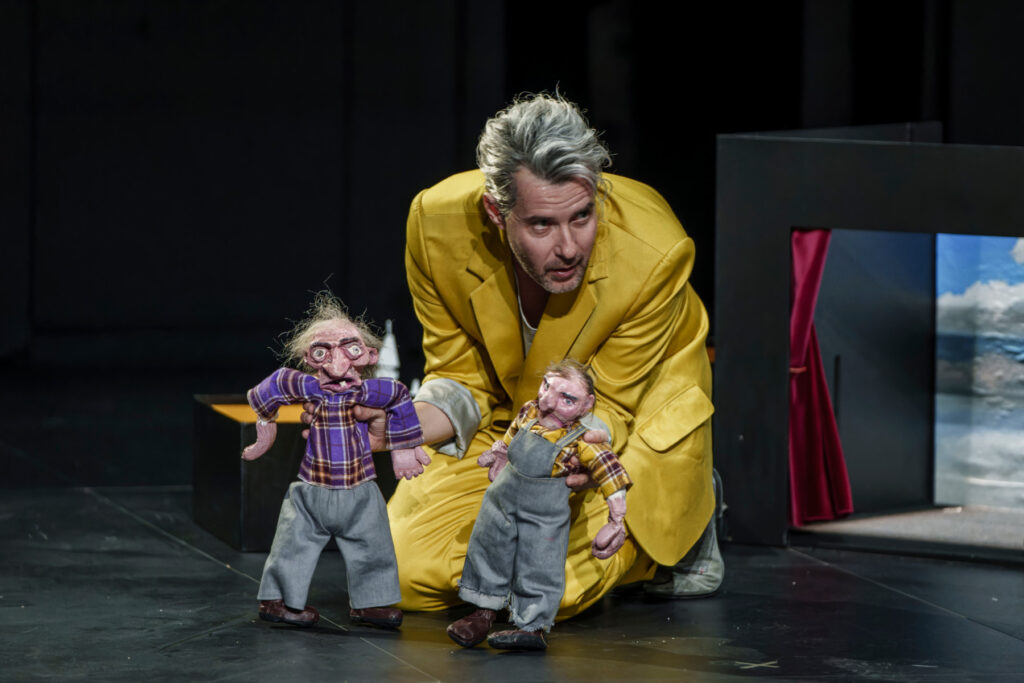
Puppets big and small played a major part, bringing fairytale wonder to harsh reality. The setting that Natascha von Steiger’s stage design provided was characterised by just a few elements positioned within the huge cubic volume. A large, open, two-level, white-framed structure rose to the left, a long dining table stood in the forestage with wooden chairs scattered around it and a stony lifeless tree trunk loomed at the rear alongside an opening in the stage that functioned as an entrance to Nibelungen, Siegfried’s forging furnace and for any means of discarding props. These elements remained at the visual core — a campfire was added to the left where the Valkyries and Mime cooked, for example, later becoming a living area at Gunther’s mansion. The lone stony tree had the company of others in Fafner’s forest in Neidhölm.
In Die Walküre, family members, including Hunding were watching over Siegmund and Sieglinde’s Act 1 first encounter. Little Siegfried and young Brünnhilde were a common presence and Wotan brought out the Ring character puppets once again. Wotan attacking Sieglinde with his spear, Erda comforting Brünnhilde in her rejection by Wotan and Brünnhilde delivering Sieglinde and little Siegfried directly to Mime were among the many licenses taken by von Peter. And a giant sword-wielding puppet of a wolf-like Siegfried closing Act 3, in all its madness, served the point of exaggerating who had the strength to change Brünnhilde’s course.
Perhaps taken from Brünnhilde’s attempts to understand how things got to be the way they are tied in with her recalling the past — it was her version and memories that seemingly had contorted reality.

When it came to Siegfried, from start to finish, the puppet show was in full force. Bobbing in the background were the puppet mermaid Rhinemaidens, a towering Fasolt, a giant toad and two disturbing wolf-headed figures representing Siegmund and Sieglinde. Fafner, in giant-green-dragon puppet form was reclining in the large-framed structure — what became Valhalla at the conclusion of Das Rheingold and to become Gunther’s mansion in Götterdämmerung — while Brünnhilde and little Siegfried made appearances too, continuing the narrative confusion. As magical as it aimed to be, the usual intimacy one would normally experience felt sadly crowded.
In between Siegfried hurtling through the flames to discover Brünnhilde and her awakening, another interruptive voiceover took hold but the tenderness of the scene continued as Siegfried gently removed the armour from a miniature Brünnhilde puppet before she joined him awestruck. Finally stripped down to their underclothes, their eventual union also had the puppets rooting for the intertwined pair. At this point, Brünnhilde’s sense of emancipation became affectingly palpable, her trepidations had slipped away and the tortured state she endured due to her abusive, iron-fisted father, who she loved, had melted away. The emotional agency of von Peter’s concept certainly showed sprouts that shot up assuredly.
So, too, in all the perennial happenings on stage, von Peter’s visual world coalesced to often conjure the illogical or dreamlike ideas of the unconscious mind in scenes of intrigue and beauty — dream and reality combined in a super-reality that similarly characterised 20th century Surrealism.
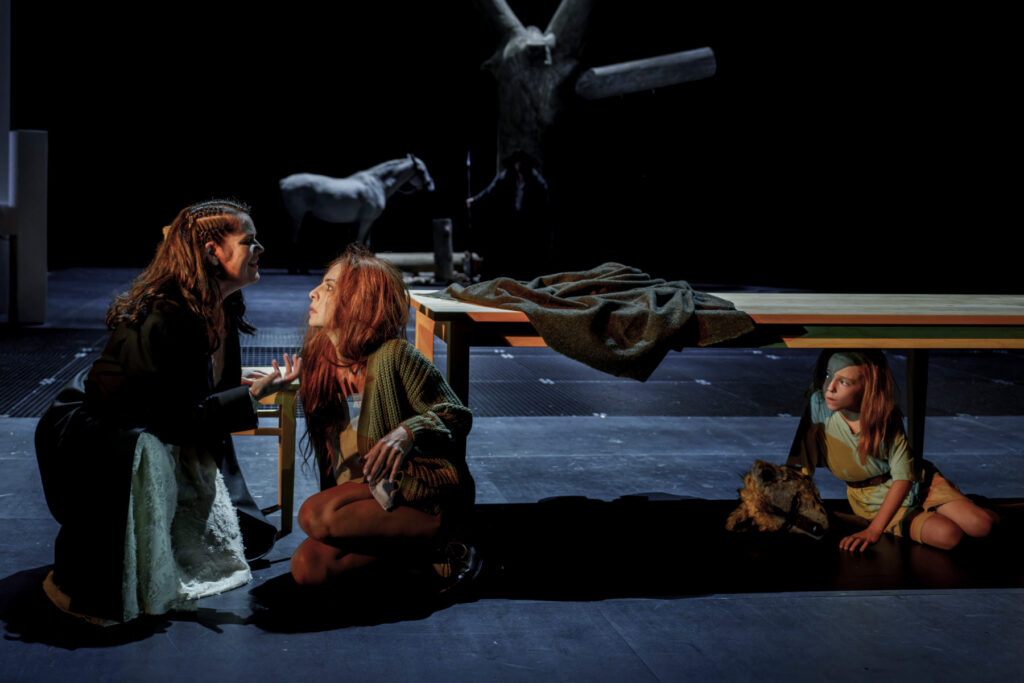
A quote from Italian Surrealist Giorgio de Chirico’s short poem, The Statue’s Wish, easily came to mind: “There is a room whose shutters are always closed. In one corner there is a book no one has ever read. And there on the wall is a picture one cannot see without weeping.”
It sums up much about the power of art and its impact on imagination and psyche. In imagery, a fine example that encapsulated the disparateness of entities evocative of another famous Surrealist artist, Salvador Dali, came in Siegfried. A mist rolled in on a soft-lit dawn as Siegfried was about to awaken Brünnhilde who was in repose on the long table, with the contingent of puppets dotted about and Grane at ease in the background. It was all detailed meticulously by Roland Edrich’s variable lighting and costume design’s by Katrin Lea Tag that harked back to the 1970s and subtly shifted to the decades beyond.
When the curtain went down on Götterdämmerung, Brünnhilde’s emancipation from the generations of control exerted by her abusive father was complete. In von Peter’s interpretation, rather than mounting her horse Grane and riding into the flames to join Siegfried in death, Brünnhilde watched on as Wotan and Alberich fought over the ring, then departed the stage, leading a procession of followers through the theatre. And it worked!

Throughout the cycle, after all the goings on, it wasn’t always clear but von Peter’s examination of the effects of Wotan’s patriarchal rule of power on subsequent generations, as seen through Brünnhilde’s hopes, disappointments and reality, provided impact and gave palpability to his concept overall. Immense humanity was brought to his characters and credibility to their actions.
In Götterdämmerung, it was really the first time that the staging took on a more realistic perspective, yet psychological aspects were never too far from being employed. In one of the most powerful moments of the cycle, Siegfried’s death was genuinely moving, depicted in a swirl of memories brought to life by persons and puppets in his life.
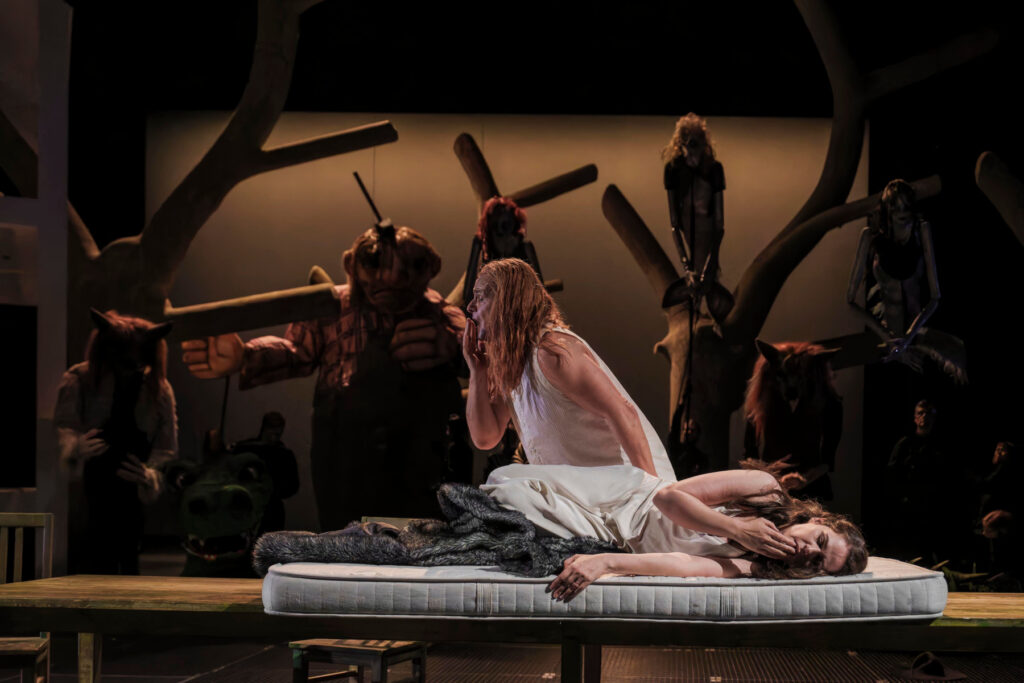
In our search for meaning we often look for ideas that support what we know. Both in the narrating and visual aspect, von Peter obliged and can’t be criticised for not incorporating all the elements that make up the Ring with ease of familiarity. Everything, down to Notung being a sword and the cursed ring being an actual ring honoured the text.
And finally to the extraordinary performances revealed. Danish soprano Trine Moller had been a constant presence throughout the Ring — her untiring commitment and expertise in vocal expressivity and acting as Brünnhilde counted for an exemplary performance. Melding technique and expression to great effect in her warm-centred, nuanced but headstrong portrayal, every note and every word carried impact and meaning.
Joining Møller’s pedestal standout performance was Canadian bass-baritone Nathan Berg with his majestic gravelly splendour and compelling acting as Wotan and The Wanderer. Looking increasingly worn and behaviourally self-centred as the cycie progressed, Berg’s rugged but keenly modulated depiction made for first-rate drama.

Swiss tenor Rolf Romei had some start-out issues as a blustery, zealous and impulsive Siegfried. Siegfried’s monumental Forging Song felt a tad fleshless and haphazard but Romei redeemed himself wonderfully with a solid performance thereon that showcased the breadth of his vocal muscularity and warmly textured instrument, elevating Siegfried’s plight excellently. He might have lacked the depth of tone one might expect but his character’s heroism shone through, meeting the demands outstandingly.
Slyly entering the picture, Irish bass-baritone Andrew Murphy maintained incisiveness and vocal heft throughout as Alberich but as the toad’s gangly brother Mime, Dutch tenor Karl-Heinz Brandt became somewhat strained. As Fricka, Lush Swiss mezzo-soprano Solenn’ Lavanant Linke outlined a memorable, scolding and slightly neurotic housewife image. German mezzo-soprano Theresa Kronthaler’s lavish-voiced and battered Sieglinde, heroic American tenor Ric Furman’s brave and zealous Siegmund and Russian bass Artyom Wasnetsov’s belting Hunding also made strong contributions.
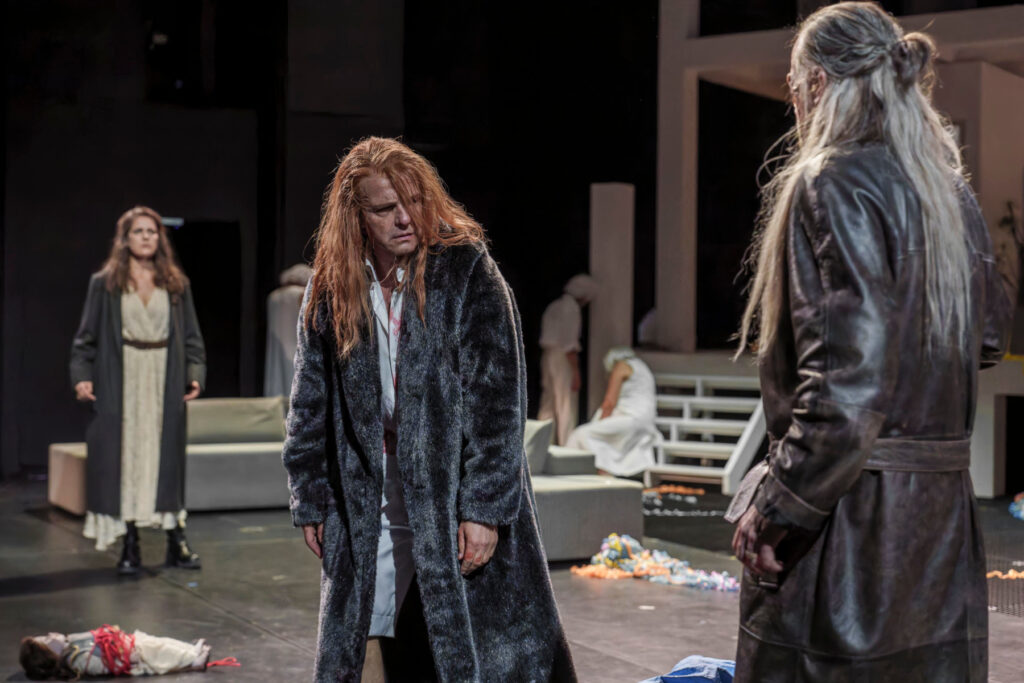
There were other solid performances as well from Patrick Zielke as a heavyweight, rumbling voiced Hagen, Günter Papendell as a flashy but impotent Gunther and Heather Engebretson’s with her energetic presence and searing top as Gutrune.
Faroe Islander Rúni Brattaberg bellowed unearthly with a suitably grounded bass as Fafner while, seen as a slightly distant-minded matriarchal figure, veteran German contralto Hanna Schwarz wasn’t always in control of the vocal demands of Erda And among the delightful memories to hold onto was how the red-feathered Woodbird entertained, strutting about and sweetly sung by Álfheiõur Erla Guõmundsdóttir.
Beautifully balanced Rhinemaidens, the tomboyish, goth Valkyries, the hardened Norns and those unmentioned all appealled plentifully. And the large chorus, both impactful and glamorous in voice as well as in their attired whites, performed a treat.
It was all worth it in the end!
Paul Selar
Der Ring des Nibelungen
A cycle of music dramas by Richard Wagner.
Click here for cast lists and other production information.
Theater Basel, Switzerland
4th – 9th June 2025
Top image: Scene from Götterdämmerung.
All photos by Ingo Höhn